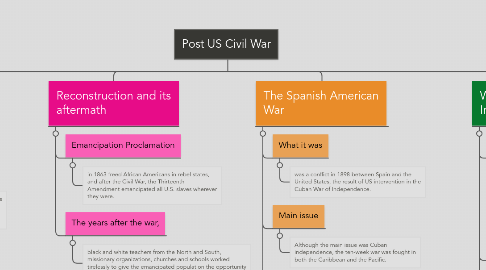
1. Post US Civil War.
1.1. Jim Crow in America
1.1.1. separated people of color from whites in schools, housing, jobs, and public gathering places.
1.2. Civil Rights
1.2.1. Denying black men the right to vote through legal maneuvering and violence was a first step in taking away their civil rights.
1.3. Song Book
1.3.1. “Jim Crow” was being used to describe laws and customs aimed at segregating African Americans and others
1.3.2. These laws were intended to restrict social contact between whites and other groups and to limit the freedom and opportunity of people of color.
2. Reconstruction and its aftermath
2.1. Emancipation Proclamation
2.1.1. in 1863 freed African Americans in rebel states, and after the Civil War, the Thirteenth Amendment emancipated all U.S. slaves wherever they were.
2.2. The years after the war,
2.2.1. black and white teachers from the North and South, missionary organizations, churches and schools worked tirelessly to give the emancipated population the opportunity to learn.
3. White Negros and Smoked Irish
3.1. What they were called
3.1.1. They considered Irish to be “niggers turned inside out”, they were even called smoked Irish. And how only white people can be citizens
3.1.2. Spoke of themselves as a race rather than a nation
3.2. Irish in the US
3.2.1. They joined in the oppression of African-Americans
3.2.2. while Irish American repealers maintained a pride and love for their homeland, they acted unabashedly American in the way they dealt with the slavery controversy
3.3. Naturalization Law of 1790
3.3.1. The aspiring citizen pledged to support the Constitution of the United States. Therefore the Irish may have hesitated to support Abolition, seeing it as a threat to the Constitution.
3.3.2. This law restricted naturalization to “free white persons” and of “good moral character”.
4. Plessy VS Ferguson
4.1. Homer Plessy
4.1.1. colored shoemaker was jailed for sitting in the "White" car of the East Louisiana Railroad
4.1.2. Plessy was only one-eighths black and seven-eighths white, but under Louisiana law, he was considered black and therefore required to sit in the "Colored" car
4.2. John Howard Ferguson
4.2.1. a lawyer from Massachusetts who had previously declared the Separate Car Act "unconstitutional on trains that traveled through several states"
4.2.2. Also the judge at the trial
4.3. Conviction
4.3.1. In Plessy's case, however, he decided that the state could choose to regulate railroad companies that operated only within Louisiana. He found Plessy guilty of refusing to leave the white car
4.3.2. Plessy appealed to the Supreme Court of Louisiana, which upheld Ferguson's decision. In 1896, the Supreme Court of the United States heard Plessy's case and found him guilty once again.
5. The Spanish American War
5.1. What it was
5.1.1. was a conflict in 1898 between Spain and the United States, the result of US intervention in the Cuban War of Independence.
5.2. Main issue
5.2.1. Although the main issue was Cuban independence, the ten-week war was fought in both the Caribbean and the Pacific.
5.3. Result
5.3.1. The result was the 1898 Treaty of Paris, negotiated on terms favorable to the US, which allowed it temporary control of Cuba, and ceded indefinite colonial authority over Puerto Rico, Guam and the Philippine islands[d] from Spain
5.4. The Yellow Kid
6. Race and Voting in the Segregated South
6.1. Voting during reconstruction
6.1.1. After the Civil War, Congress acted to prevent Southerners from re-establishing white supremacy
6.1.2. This Reconstruction amendment prohibited states from denying “the equal protection of the laws” to U.S. citizens, which included the former slaves.
6.1.3. The 15th Amednment was ratified. It stated that, “The right of citizens of the United States to vote shall not be denied or abridged by the United States or by any State on account of race, color, or previous condition of servitude.”
6.1.4. . For the first time, black men and women enjoyed freedom of speech and movement, the right of a fair trial, education for their children, and all the other privileges and protections of American citizenship.
6.2. Voting in Mississippi
6.2.1. Black voting fell off sharply in most areas because of threats by white employers and violence from the Ku Klux Klan, a ruthless secret organization bent on preserving white supremacy at all costs.
6.2.2. White majorities began to vote out the Republicans and replace them with Democratic governors, legislators, and local officials. Laws were soon passed banning interracial marriages and racially segregating railroad cars along with the public schools.
6.2.3. Laws and practices were also put in place to make sure blacks would never again freely participate in elections.
6.2.4. . But one problem stood in the way of denying African Americans the right to vote: the 15th Amendment, which guaranteed them this right.
